Shikoku Geranium Geranium shikokianum
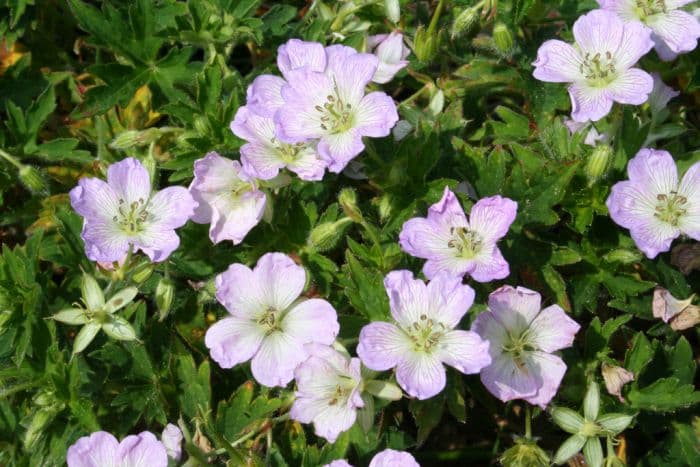
ABOUT
The plant known as Geranium shikokianum features a distinctive and attractive appearance. The foliage of this plant consists of round to kidney-shaped leaves, which are often deeply lobed, giving them a somewhat intricate look. The leaves might exhibit a rich green color, creating a lush backdrop for the flowers. The blooms are where this plant truly shines, with notable petals that range in color, usually displaying shades of pink or purple. These flowers typically have a rounded shape with five distinct petals, each adorned with delicate veining that may be of a darker hue than the rest of the petal, adding to the visual interest of the plant. Accentuating the flowers are the stamens, which are prominent and lend an additional texture to the floral display. The overall look of the plant is enhanced by its growth habit, with the flowers rising above the foliage in a way that makes them appear to float, providing a soft and aesthetically pleasing aspect to gardens where it's planted.
About this plant
 Names
NamesFamily
Geraniaceae
Synonyms
Shikoku Geranium, Shikokianum Geranium
Common names
Geranium shikokianum.
 Toxicity
ToxicityTo humans
Geranium shikokianum, commonly known as Shikoku geranium, is not considered highly toxic to humans. However, ingestion of plant parts may cause mild gastrointestinal upset, such as nausea, vomiting, or diarrhea. It is advisable to keep all plants out of the reach of young children who might ingest them out of curiosity.
To pets
Shikoku geranium is generally not considered highly toxic to pets such as dogs and cats. If ingested, it may cause mild gastrointestinal upset, including symptoms such as vomiting or diarrhea. It is always best to prevent pets from consuming plants to avoid any potential discomfort or more serious complications in animals with particular sensitivities.
 Characteristics
CharacteristicsLife cycle
Perennials
Foliage type
Deciduous
Color of leaves
Green
Flower color
White
Height
1 feet (30 cm)
Spread
1 feet (30 cm)
Plant type
Herb
Hardiness zones
5
Native area
Japan
Benefits
 General Benefits
General Benefits- Ornamental Value: Geranium shikokianum, also known as Shikoku geranium, offers beautiful foliage and attractive flowers that enhance the aesthetic appeal of gardens and landscapes.
- Low Maintenance: Shikoku geranium is known for being low maintenance, making it suitable for gardeners of all skill levels.
- Drought Tolerance: Once established, this plant is fairly drought-tolerant, reducing the need for frequent watering.
- Pest Resistance: The plant is generally resistant to many common garden pests, which minimizes the need for chemical pesticides.
- Attracts Pollinators: The flowers of the Shikoku geranium attract bees and butterflies, which are important pollinators for the garden ecosystem.
- Ground Cover: This species can serve as an effective ground cover, reducing soil erosion and suppressing weed growth.
 Medical Properties
Medical PropertiesThis plant is not used for medical purposes.
 Air-purifying Qualities
Air-purifying QualitiesThis plant is not specifically known for air purifying qualities.
 Other Uses
Other Uses- The leaves of Geranium shikokianum can be used as a natural insect repellent due to their aromatic properties, which some insects may find unattractive.
- Geranium shikokianum can be planted as a ground cover in gardens to reduce soil erosion thanks to its dense growth habit.
- The flowers can be used in floral arrangements as filler elements, providing a delicate and whimsical touch to bouquets.
- The plant can also be used in the practice of companion planting to deter pests from other more vulnerable garden crops.
- Dried Geranium shikokianum petals can be incorporated into potpourri mixes for a subtle fragrance in the home.
- The vibrant colors of the flowers can serve as a natural dye for fabrics or art projects, yielding shades of pink and purple.
- Pressed Geranium shikokianum flowers can be used in crafting, such as in handmade paper or resin jewelry, showcasing the plant's beauty.
- Leaves of Geranium shikokianum may be used as bookmarks due to their flat shape and decorative appearance after being pressed and dried.
- The plant can be grown in outdoor containers to add a splash of color to patios, balconies, or other outdoor living areas.
- Geranium shikokianum's natural hardiness makes it suitable for use in teaching gardening techniques to beginners, demonstrating proper plant care.
Interesting Facts
 Feng Shui
Feng ShuiThe Geranium is not used in Feng Shui practice.
 Zodiac Sign Compitability
Zodiac Sign CompitabilityThe Geranium is not used in astrology practice.
 Plant Symbolism
Plant Symbolism- Balance: Geraniums are commonly associated with balance as their symmetrical petal arrangement is thought to symbolize an equilibrium in all aspects of life.
- Unexpected Meeting: In the language of flowers, geraniums can hint towards a chance encounter or a surprise rendezvous, embodying the plant's capability to grow and thrive unexpectedly.
- Good Health: The geranium is often recognized as a symbol of good health and long life, reflecting the plant's use in traditional herbal remedies and its hardy nature.
- Friendship: Offering a geranium can be seen as a gesture of warmth and friendliness, representing the enduring nature of true friendship.
 Water
WaterShikokianum Geranium prefers consistent moisture, so it should be watered when the top inch of its soil feels dry to the touch. Generally, this equates to watering approximately once a week, but this frequency can vary depending on environmental conditions such as temperature and humidity. Provide about one to two gallons of water to thoroughly soak the soil, ensuring that excess water drains out so the roots are not sitting in water, as this can lead to root rot. During the winter months, reduce watering since the plant's growth slows down, but still keep the soil slightly moist.
 Light
LightShikokianum Geranium thrives in partial shade to full sun conditions. The best spot for this plant is one where it will receive morning sunlight and afternoon shade, or dappled sunlight throughout the day. Protecting the geranium from the intense heat of the midday sun will help to keep the foliage healthy and prevent scorching.
 Temperature
TemperatureShikokianum Geranium prefers moderate temperatures and can generally tolerate temperatures between 50°F and 75°F. It can survive short periods of colder temperatures down to about 30°F but should be protected from frost. The ideal temperature range for optimal growth is between 60°F and 70°F.
 Pruning
PruningPruning Shikokianum Geranium is essential to maintain its shape and encourage denser foliage. Prune the plant in late winter or early spring before new growth begins. Remove any dead or damaged leaves and stems as well as any leggy growth to promote healthier, more vigorous growth. Deadheading spent flowers regularly will also encourage further blooming.
 Cleaning
CleaningAs needed
 Soil
SoilThe best soil mix for Shikoku Geranium is a well-draining mix with a neutral to slightly acidic pH between 5.8 to 6.5. One can use a mixture of loam, peat moss, and perlite or sand in equal parts to ensure good aeration and drainage.
 Repotting
RepottingShikoku Geraniums should be repotted every two to three years or when the plant outgrows its current container. Spring is the best time for repotting to minimize stress on the plant.
 Humidity & Misting
Humidity & MistingShikoku Geranium prefers moderate humidity levels but is adaptable to average household humidity. Ensure proper ventilation to prevent disease, especially if humidity is higher.
 Suitable locations
Suitable locationsIndoor
Place in bright, indirect light and ensure well-draining soil.
Outdoor
Plant in partial shade, shelter from strong winds.
Hardiness zone
5-9 USDA
 Life cycle
Life cycleGeranium shikokianum, commonly known as Shikoku cranesbill, begins its life cycle as a seed that germinates in moist, well-drained soil typically in the spring. The seedlings develop into rosettes of foliage and, given proper conditions of light and moisture, the plant will grow into a mature specimen with distinctive, deeply lobed leaves. The Shikoku cranesbill reaches its flowering stage in late spring to early summer, producing white to pale pink flowers with distinct veining. After pollination, typically by insects, the plant sets seed in a unique, beak-like capsule that gives the plant its common name, cranesbill. Once the seeds have matured, the structure splits and the seeds are dispersed, often by wind or foraging animals. In the fall or at the onset of colder temperatures, the plant may die back, entering a period of dormancy, although in some climates it may retain its foliage year-round.
 Propogation
PropogationPropogation time
Spring to Summer
Propogation: Geranium shikokianum, commonly known as Shikoku geranium, is most commonly propagated by division, which is ideally done in spring. To propagate by division, carefully dig up the plant while trying to keep the root ball intact. Using a sharp, clean knife or spade, split the root ball into smaller sections, ensuring that each section has a good portion of roots and some shoots. Replant the divisions at the same depth they were growing before and water them thoroughly. This method stimulates new growth and helps to maintain the health and vigor of the parent plant.
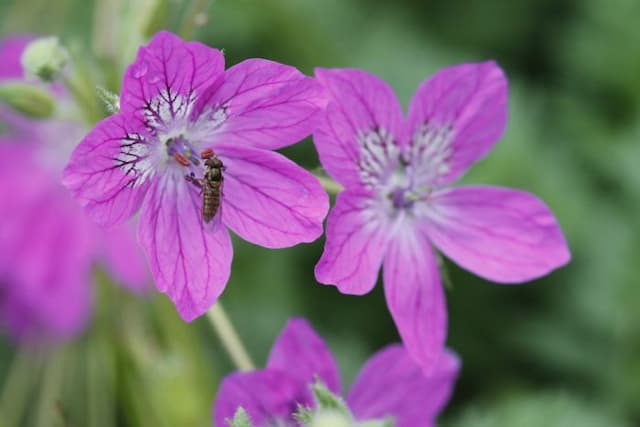
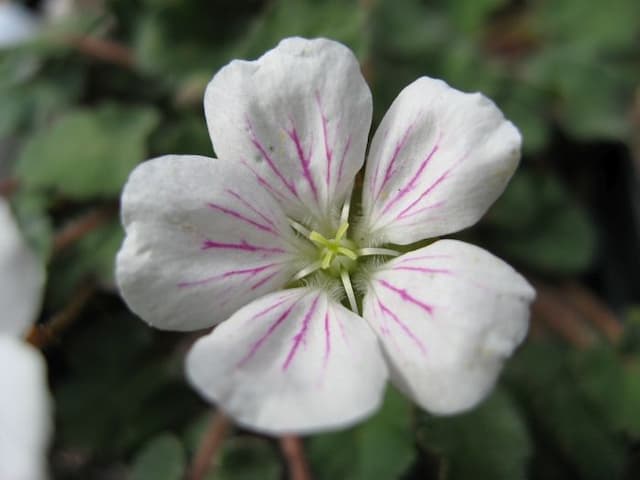
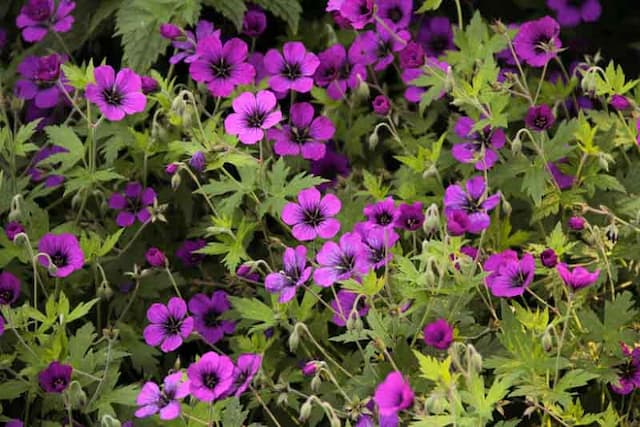
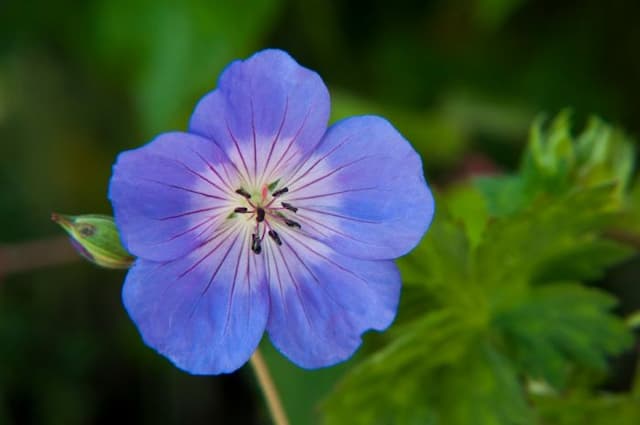


![Cranesbill [Rothbury Gem]](/_next/image?url=https%3A%2F%2Fplants-admin.emdemapps.com%2Fimages%2Fplants%2F%2Fimages%2F604b6243984c2.png&w=640&q=75)


